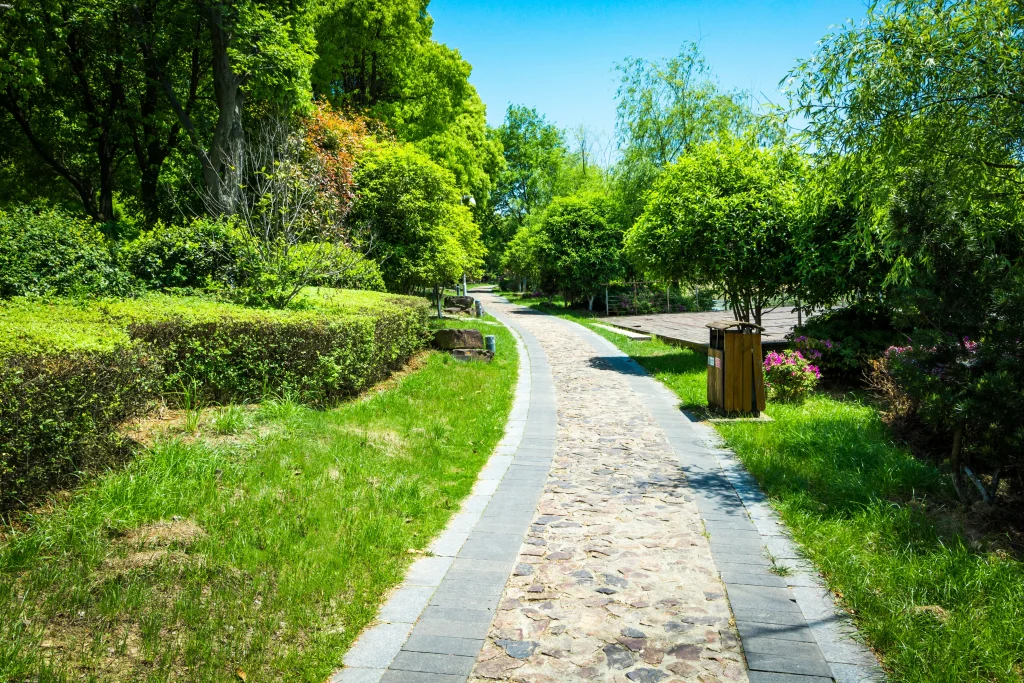Nothing frustrates homeowners than watching weeds pop through expensive rock landscaping. If you’ve invested in decorative rocks only to face battles with bindweed, dandelions, or cheatgrass, you’re not alone.
This comprehensive guide provides step-by-step weed control in rocks solutions and prevents weeds in rock beds for good. You’ll learn the best weed killer for rock beds, proven pre-emergent for rock beds, and fabric installation techniques that actually work.
Let’s take back your landscape and enjoy the clean, polished look of your rock garden.
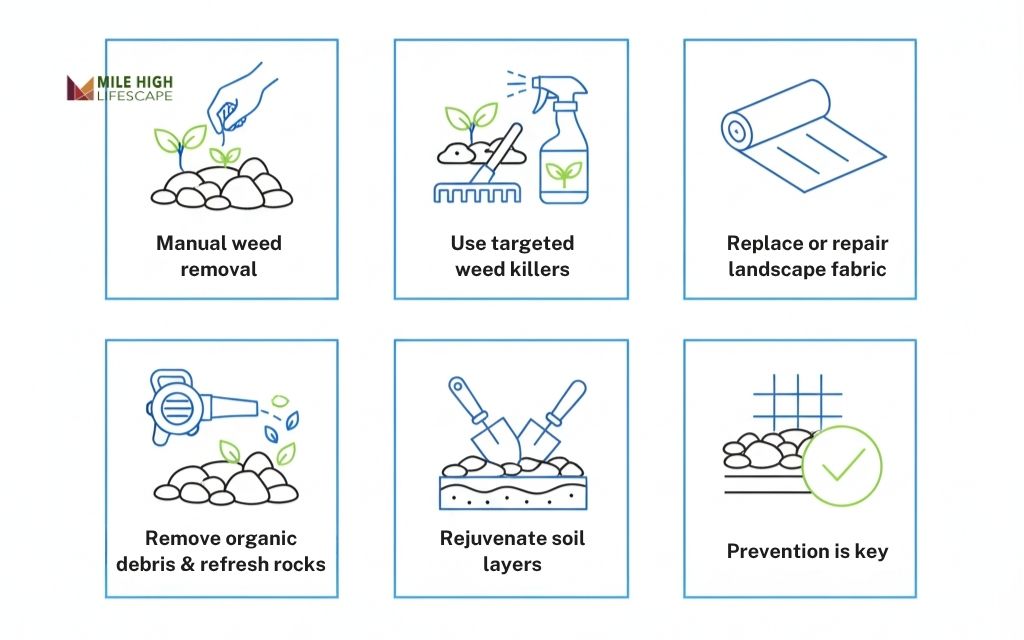
Common weeds in rock landscaping
Even with rock beds and fabric barriers, certain hardy weed species thrive in dry climate and rocky soil. Knowing which types are the first step toward long-term weed control in rocks.
Here are the most common culprits homeowners face:
Bindweed
This deep-rooted perennial vine is notorious for regrowing from tiny root fragments left behind during removal attempts. Bindweed can penetrate weak landscape fabric and resurface even after herbicide treatment, making it one of the most challenging weeds in rock landscapes.
Dandelions
While commonly associated with lawns, dandelions easily colonize rock beds when their windborne seeds find pockets of soil between rocks. Their thick taproots make complete removal challenging, and a single flower head can produce over 200 seeds.
Cheatgrass
This fast-spreading annual grass thrives in dry, rocky conditions – precisely the environment created by rock landscaping. Beyond being an aesthetic nuisance, cheatgrass poses a serious fire risk during Denver’s summer droughts when its dry seed heads become highly flammable.
Thistle
These aggressive biennial weeds develop deep taproots and produce thorny leaves that make handling unpleasant. Thistle seeds remain viable in Denver soils for up to 10 years, creating long-term management challenges.
Crabgrass
This warm-season annual weed flourishes in thin gravel layers and moist spots near sprinklers or irrigation zones. Once established, crabgrass spreads rapidly, forming clumps that disrupt the uniform appearance of rock landscaping.
Purslane
This low-growing annual spreads across hot, dry surfaces—making Denver’s sunny rock beds perfect habitat. Purslane’s succulent nature allows it to survive with minimal water, and broken stem fragments can reroot, making mechanical removal tricky.
Spurge
Spurge grows low and spreads wide, forming mat-like growth that can smother desirable groundcovers. It emits milky sap when broken that can irritate skin, making hand removal unpleasant.
Goathead
Perhaps the most dreaded weed, goathead produces hard, spiky seed pods that puncture bike tires, pet paws, and bare feet. Seeds remain viable for up to 5 years in soil, creating multi-year control challenges.
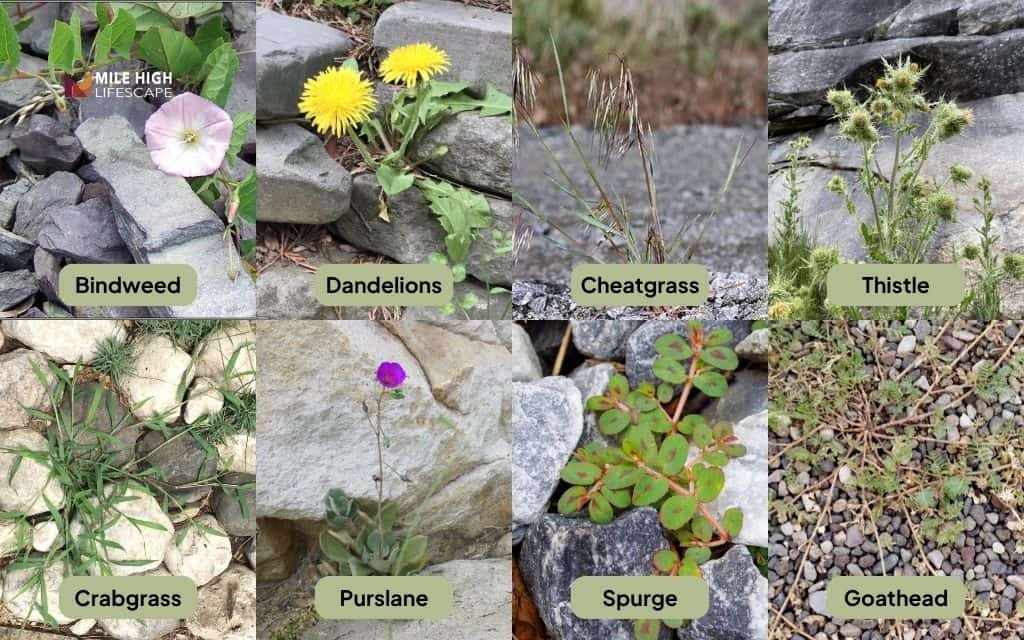
Weed control in rocks: How to get rid of weeds in rock landscaping
When weeds have already invaded your rock beds, thorough cleanup is necessary before implementing prevention strategies. The goal is to eliminate existing weeds completely, creating a clean slate for long-term weed control in rocks.
Here are some proven removal methods:
Manual weed removal
For scattered weeds or small problem areas, hand removal remains the most targeted approach that won’t affect surrounding landscape plants.
- Use a weeding knife, hori-hori blade, or specialized hand puller to remove weeds by the root
- Lightly moisten the area with water 15-30 minutes before removal to loosen compacted soil
- For deep-rooted invaders (bindweed, thistle, dandelions), loosen soil with a screwdriver or soil knife before pulling
- Remove weeds into buckets rather than leaving them on rock surfaces
Remove weeds before they flower or set seed. Denver’s dry winds can scatter seeds across your entire property within days of seed head formation.
Use targeted weed killers
When manual removal isn’t practical or weeds keep returning, targeted herbicide application provides more lasting control.
Denver homeowners can choose between organic and chemical options based on their preferences and situation.
Organic / natural weed killer
- Vinegar spray: Mix 1 gallon white vinegar (5% acidity or higher) + 1 cup salt + 1 teaspoon dish soap. Spray directly on weeds during sunny morning hours. The vinegar burns foliage, salt dehydrates roots, and dish soap helps the solution adhere.
- Boiling water: Pour directly onto small weed patches between rocks. This method kills roots instantly through thermal shock and works well for weeds growing in cracks or tight spaces.
- Torch weeder: Flame-weeding tools use propane to burn seedlings and surface roots. This method works best for gravel driveways, rock borders, and areas away from combustible materials. Pass flame over weeds rather than burning them.
- Corn gluten meal: Acts as both an organic pre-emergent and mild weed suppressant. Apply at 20 pounds per 1,000 square feet in early spring before weed seeds germinate.
Organic methods require repeat applications and work best on young weeds. They’re less effective on established perennials with extensive root systems.
Chemical weed killer
When weeds have overrun your rock beds or you’re dealing with persistent perennial species, professional-grade herbicides provide more comprehensive control:
Application tips:
- Apply on calm, dry mornings
- Avoid application before rain (wait 24-48 hours for absorption)
- Use spray shield or cardboard barrier to protect nearby plants
- Mark treated areas to prevent accidental contact during drying period
Always read and follow label instructions. Wear protective clothing including gloves and eye protection. Keep pets and children away from treated areas until products have dried completely (typically 2-4 hours).

Remove organic debris & refresh rocks
Accumulated debris creates ideal germination conditions for weed seeds, so regular cleaning is essential for weed control in rocks.
- Use a leaf blower to remove leaves, seed debris, and decayed matter from rock surfaces
- Rake or use a specialized gravel rake to level rocks and expose bare spots
- Where soil has mixed with rocks over time, sift and separate or replace the top 1-2 inches with fresh rock
- Check for and remove any moss or algae growth, which holds moisture that encourages weed germination
Replace or repair landscape fabric
If weeds persistently push through your rock beds, damaged or inadequate landscape fabric is often the culprit. Quality weed barrier installation makes a dramatic difference in long-term results.
When to replace:
- Weeds are growing through fabric in multiple locations
- Fabric is torn, degraded, or pulling away from edges
- You can see soil through fabric gaps or thin spots
- Original installation used plastic sheeting instead of proper landscape fabric
Installation process:
- Remove existing materials: Clear rocks and debris completely. Remove old fabric if present.
- Prepare base layer: Level and compact soil. Remove any remaining root systems. Consider adding 1-2 inches of compacted crushed granite for enhanced drainage and weed suppression.
- Install quality fabric: Use commercial-grade woven landscape fabric rated at 5-8 oz. density. This weight offers the best balance of weed blocking, durability, and water permeability.
- Overlap properly: Overlap fabric seams by 8-12 inches in all directions. This prevents weeds from finding gaps between sheets.
- Secure thoroughly: Insert steel landscape staples every 12 inches along edges and seams. Standard plastic staples often fail in Denver’s freeze-thaw cycles.
- Cut strategic openings: For existing shrubs or trees, cut X-shaped slits and fold fabric around bases. Secure with extra staples and cover edges completely with rock.
- Add rock layer: Apply 2-3 inches of fresh decorative rock over fabric. This protects fabric from UV damage and provides weight to prevent shifting.
If fabric replacement seems overwhelming, Mile High Lifescape offers rock landscaping services that include fabric installation, proper base preparation, and rock replacement.
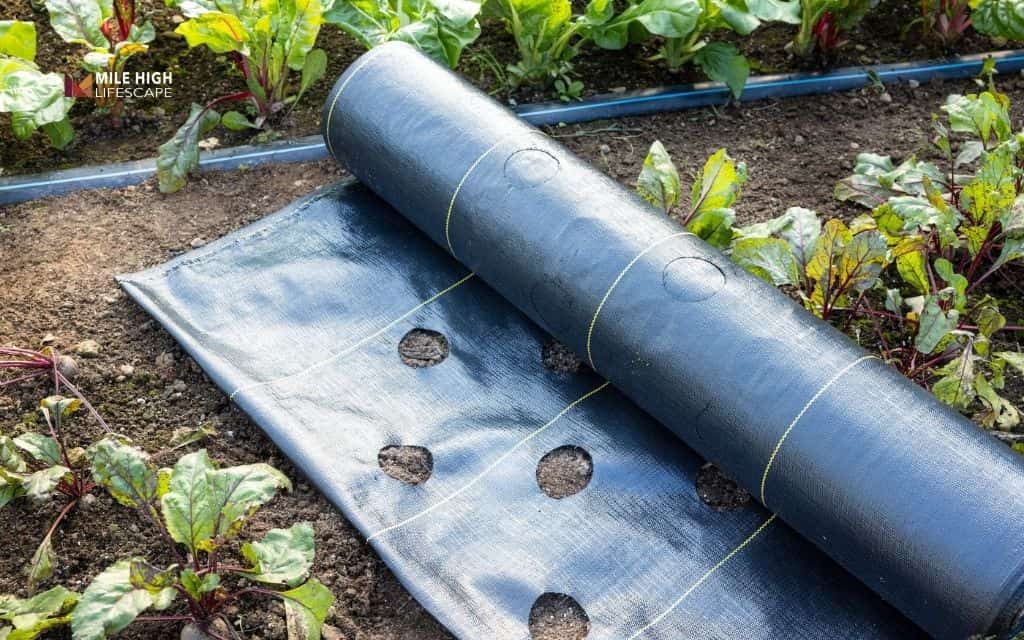
Rejuvenate soil layers
When weeds have established extensive root systems beneath fabric, surface treatments won’t solve the problem. In these cases, complete bed renovation provides the most effective long-term solution.
- Excavation: Remove all rocks and set aside for reuse. Remove existing fabric completely.
- Root removal: Dig out top 4-6 inches of soil, removing all visible root systems. Dispose of weed-contaminated soil rather than relocating it elsewhere in your landscape.
- Base layer installation: Replace removed soil with 3-4 inches of compacted road base or crushed granite (Class 5 or 6 material). This creates a sterile, compacted foundation highly resistant to weed seed germination.
- Fabric installation: Install new commercial-grade landscape fabric following proper techniques outlined above.
- Rock replacement: Add 2-3 inches of decorative rock. Consider refreshing with new rock if the original material has degraded or become soil-contaminated.
How to prevent weeds in rock beds
Once your rock beds are clean, prevention becomes your primary focus. The right combination of physical barriers, chemical pre-emergents, and consistent maintenance keeps weeds from returning.
Here’s how to implement prevention strategies:
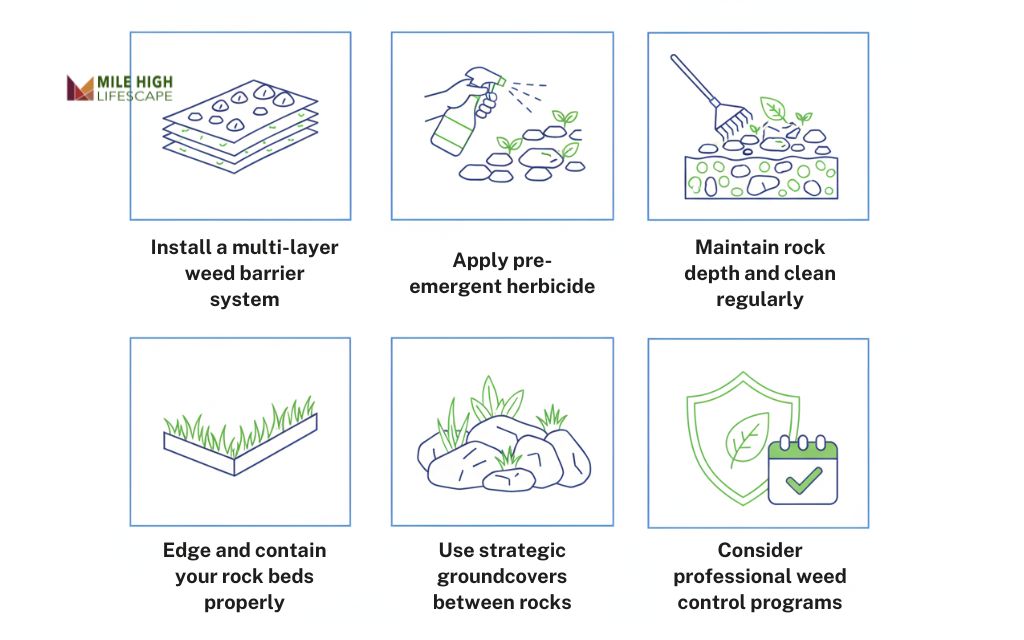
Install a multi-layer weed barrier system
Professional landscapers know that single-layer approaches rarely provide lasting weed control in rocks. A properly constructed three-layer system addresses drainage, weed blocking, and surface stability simultaneously.
Recommended 3-Layer Setup:
Base layer (drainage support)
2-3 inches of compacted crushed gravel, decomposed granite, or road base. This layer:
- Improves drainage to prevent water pooling that encourages weed growth
- Creates stable foundation that resists frost heaving during freeze-thaw cycles
- Provides compact, sterile material that resists weed root penetration
Middle layer (weed barrier)
Heavy-duty woven landscape fabric rated at minimum 5 oz. density (professional grade is 6-8 oz.). Quality fabric offers:
- Superior tear resistance against roots and ground movement
- Water permeability that prevents moisture accumulation
- UV resistance when properly covered with rock
- Breathability that prevents anaerobic soil conditions
Top layer (decorative rock)
2-3 inches of decorative rock material. This protective layer:
- Shields fabric from UV degradation
- Provides weight that prevents fabric shifting
- Creates visual appeal while blocking light from reaching fabric surface
- Reduces temperature extremes that stress fabric materials
Apply pre-emergent herbicide
The best pre-emergent for rock beds stops weed seeds from germinating before they ever become visible problems. This proactive approach reduces the need for post-emergent treatments and hand weeding.
How pre-emergents work
These products create a chemical barrier in the top inch of soil that prevents seed germination without affecting established plants. Seeds that encounter this barrier either fail to germinate or die during the germination process.
Application timing
- Early spring application: Apply in early to mid-March when soil temperatures consistently reach 50-55°F. This timing intercepts the first wave of annual weed germination including crabgrass, spurge, and purslane.
- Fall application: Apply in mid-October before winter annual germination. This targets cheatgrass, bindweed seedlings, and winter weeds that germinate in fall and overwinter as small plants.
Application tips
- Water lightly after application to activate the chemical barrier (0.25-0.5 inches)
- Apply before weeds emerge
- Reapply every 6-9 months for continuous protection
- Use spreader settings recommended on product labels for even coverage
- Avoid disturbing soil after application, which breaks the chemical barrier
Maintain rock depth and clean regularly
Proper rock depth and consistent cleaning are perhaps the most effective prevention strategies.
Maintain 3-4 inches of rock coverage throughout beds. This depth:
- Blocks sufficient sunlight to prevent photosynthesis in germinating seeds
- Prevents windblown seeds from reaching soil surface
- Protects landscape fabric from UV damage
- Provides thermal mass that moderates soil temperature swings
Monthly maintenance routine (10-15 minutes):
- Blow or rake leaves, seeds, and organic debris from rock surfaces
- Check for thin spots and redistribute rocks as needed
- Inspect edges for grass or weed encroachment
- Remove any visible weeds immediately before they establish
Find step-by-step instructions for cleaning landscape rocks here.
Edge and contain your rock beds properly
Even the best weed killer for the rock landscape won’t stop grass, tree roots, and perennial weeds from creeping laterally into rock beds from surrounding areas.
Professional edging creates physical barriers that contain your rock beds and exclude invaders.
| Types | Details |
| Steel Edging | – Provides rigid barrier grass roots cannot penetrate – Bends smoothly for curved designs – Lasts 20+ years with minimal maintenance – Typically 4-6 inches deep, anchored with stakes |
| Stone or Brick Borders | – Aesthetic appeal with functional weed blocking – Should be set in concrete or compacted base for stability – Width of 6-8 inches provides substantial barrier |
| Plastic Edging | – Less durable than metal or stone – Can shift during freeze-thaw cycles – Requires more frequent inspection and adjustment – Better than no edging, but expect 5-10 year lifespan |
Use strategic groundcovers between rocks
Low-growing plants can naturally outcompete weeds while adding visual interest and ecological value to rock landscapes.
| Types | Details |
| Creeping Thyme | – Forms dense mat only 2-3 inches tall – Tolerates foot traffic between stepping stones – Fragrant purple flowers attract pollinators – Thrives in full sun with minimal water |
| Sedum Species | – Succulent foliage requires almost no supplemental water – Available in multiple colors (green, burgundy, gold) – Spreads slowly to fill gaps without becoming invasive – Excellent for slopes and challenging areas |
| Ice Plant | – Brilliant flowers in pink, yellow, or purple – Extremely drought-tolerant once established – Evergreen foliage provides year-round coverage |
Consider professional weed control programs
When DIY approaches aren’t providing desired results, professional weed control services offer comprehensive solutions backed by commercial-grade products and expertise.
Benefits:
- Access to commercial-grade pre-emergent and herbicides unavailable to consumers
- Proper timing based on seasonal weed cycles and weather patterns
- Equipment for efficient application across large areas
- Expertise identifying specific weed species and selecting optimal treatments
- Liability insurance protecting against accidental damage
- Consistent results without requiring your time and effort
Conclusion
Weeds in rock landscaping are preventable with the right approach. Successful weed control in rocks combines proper installation, proactive prevention, and consistent maintenance.
The key to long-term success lies in layering multiple strategies. Quality landscape fabric, 3-4 inches of rock depth, seasonal pre-emergent applications, and simple quarterly maintenance create a comprehensive defense system that keeps weeds away year after year.
Check out more useful articles on rock landscaping here:
- Water-wise river rock flower beds: 15 creative designs for Denver gardens
- 10 modern black rock landscape ideas for Denver homes
- 21 landscape designs with river rock that transform ordinary yards into water-wise retreats
- Front yard rock and mulch landscape pictures: 17 stunning Denver ideas
__________
Your Denver Rock Bed Weed Control Experts
Mile High Lifescape has been Denver’s trusted provider of professional rock landscaping services, specializing in weed-free rock bed installation and long-term maintenance solutions. Our expert team understands Colorado’s climate challenges – from bindweed and cheatgrass to thistle. We install commercial-grade landscape fabric, apply professional pre-emergents, and create properly layered rock beds that stay beautiful and weed-free year after year.
Ready to enjoy truly low-maintenance rock landscaping?
Call Mile High Lifescape: (303) 877-9091
Frequently asked questions (FAQ)
Can I use vinegar instead of chemical weed killer?
Yes, for small infestations of young weeds. Mix 1 gallon white vinegar + 1 cup salt + 1 teaspoon dish soap. Apply on sunny mornings above 60°F. However, vinegar only burns top growth and won’t kill deep-rooted perennials like bindweed or thistle – those require systemic herbicides.
Should I remove all rocks to get rid of weeds?
Only if fabric is severely damaged or absent, or if weeds have extensive underground roots. Most situations can be handled with thorough weed removal, pre-emergent application, and proper maintenance without complete rock removal.
How often should I reapply pre-emergent?
Every 6-9 months is optimal. Apply in early spring (March) and fall (October) to maintain continuous weed prevention. If weeds break through sooner, you may need to increase application rates or check for disturbed chemical barriers.
How deep should rocks be to prevent weeds?
Maintain 3-4 inches minimum depth throughout all beds. This blocks sunlight from reaching soil, protects fabric from UV damage, and prevents windblown seeds from reaching the surface. Add fresh rock every 2-3 years as rocks settle.
Do I need landscape fabric if I use thick rock?
Yes. Fabric blocks light at soil level, prevents soil mixing with rocks, suppresses deep-rooted perennials, and provides structural separation. Rock depth alone can’t prevent all weeds since seeds settle between rocks and some aggressive weeds penetrate from below. The combination works best.
